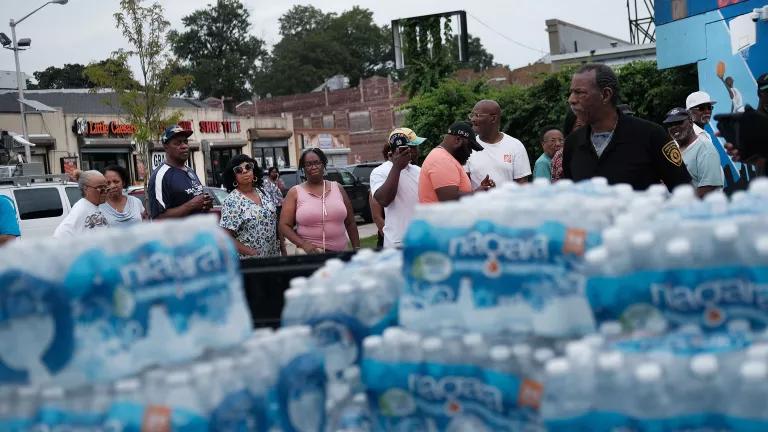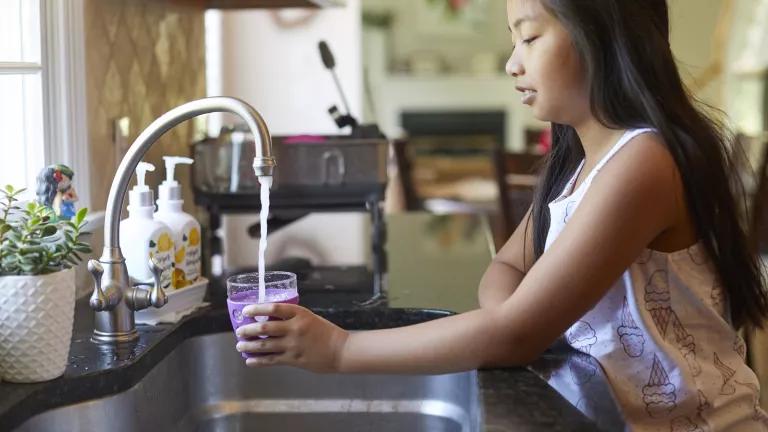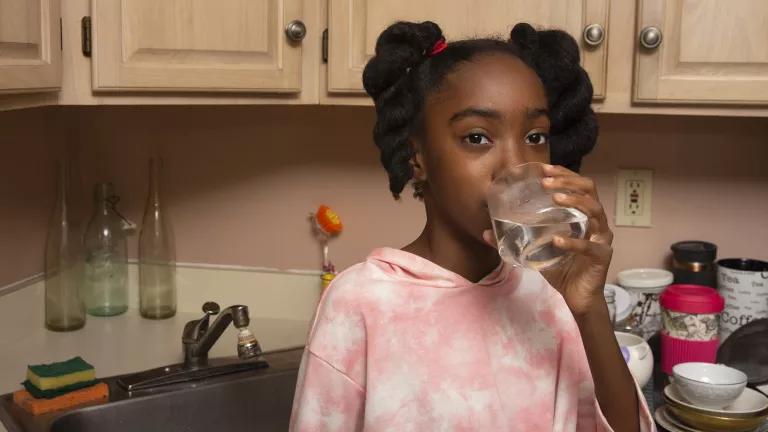Water vs. Energy: Solving the COVID-19 Utility Crisis
States and the federal government must act now to preserve essential water service during the pandemic—and keep customers from being mired in debt they cannot escape.

mrjn Photography via Unsplash
[Updated 12/22/20 to reflect new federal assistance funds appropriated on Dec. 21, 2020.]
States and the federal government must act now to preserve essential water service during the pandemic—and keep customers from being mired in debt they cannot escape.
As described in a companion blog published today, the solutions for water and energy service are largely similar, in concept. But to craft effective policies and programs, policy makers must understand important differences between the water and energy utility sectors and adapt the solutions as needed.
The companion blog summarizes six key distinctions—and the implications for policy makers. These are explored in more detail below.
1. Who must act to establish water protections?
For most water customers, legal protections must come from governors, state legislatures, and the federal government. The vast majority of electric and gas customers are served by investor-owned companies. They are subject to oversight by state utility commissions, which regulate customer rates, establish and enforce consumer protections, and often mandate and/or administer programs to support low-income customers. Privately owned water utilities are also regulated by the same commissions. But 88 percent of people on public water service (as opposed to private well water) are served by publicly owned water utilities. With the exception of just a few states (Wisconsin, Maine, and Indiana), those systems—tens of thousands of them—are not regulated by state utility commissions, or by any comparable oversight body.* Yet, many statewide utility shutoff moratoria were enacted exclusively through utility commission orders, leaving out most water customers.
The federal government also has offered no shutoff protections. The COVID-19 relief legislation the House passed back in May (and passed again in October in revised form), known as the Heroes Act, included a nationwide utility shutoff moratorium, for the duration of the COVID-19 state of emergency and for 120 days beyond. But while water and wastewater utilities are seeking federal relief funds for customers and for themselves, they have resisted a nationwide moratorium, and the COVID-19 relief bill that finally passed on December 21, 2020 includes no utility shutoff protections.
The Centers for Disease Control and Prevention (CDC) has also refused calls for a nationwide water shutoff moratorium. When members of Congress and over 120 organizations called on the CDC to bar water shutoffs—citing the same legal authority the agency invoked for its eviction moratorium—the CDC director’s response suggested that people use hand sanitizer if they have no water and callously advised that dirty water is better than none at all for personal hygiene.
- Solutions: Governors, state legislatures, and the federal government must act now to create protections or to restore those that have lapsed. Where states have enacted COVID-19 protections through executive order or legislation, all water customers have been protected. And the federal government, through Congress or the CDC, has ample power to stop water shutoffs during the pandemic.
2. What customer protections pre-dated COVID?
Before the pandemic, water systems were largely exempt from states’ baseline utility consumer protections. State utility commissions typically have various consumer protection rules for all utilities they regulate. These rules address such issues as minimum notice requirements for shutoffs, prohibitions on shutoffs for certain vulnerable customers (e.g., based on specific medical needs) or at certain times of year (i.e., during winter heating season), fair billing practices, dispute resolution procedures, and a right to enter an extended payment plan when a customer cannot pay in full.
In contrast, pre-COVID-19, there were virtually no state consumer protections applicable to the vast majority of water utilities. California appears to be the only state that had even basic safeguards on the use of water shutoffs for non-payment. Moreover, at the local level, pre-pandemic shutoff policies vary tremendously—some cities and towns routinely use shutoffs to enforce non-payment, others not at all. And many publicly owned water and sewer systems use property liens to enforce unpaid bills, which can lead people to lose their homes to foreclosure, suffer serious adverse health consequences, and even lose custody of their children.
- Solutions: States and the federal government must adopt protections immediately, given the near-complete lack of pre-existing water protections. For energy utility customers, baseline protections certainly are not sufficient for the COVID-19 emergency (and were imperfect to begin with), creating an urgent need to protect utility customers broadly. For water, when states and the federal government fail to step in, most people have no guaranteed protections—not even the annual winter shutoff moratoria that apply to electric and gas service in many states.
3. What do we know about the scope of the problem?
Data are more limited than in the energy sector, but all signs point to a mountain of customer debt and tens of millions of people at risk of shutoff. In the energy sector, data are far from complete. But the available data has supported national estimates of the amount of funding needed to address customer arrears. Some state utility commissions have required reporting of basic information during COVID-19, such as the number of customers disconnected, reconnected, and in arrears and the total dollar amounts of customer arrears. Outside of commissions, however, states have been slow to act. For example, despite an executive order establishing a statewide utility shutoff moratorium, California has refused to require reporting by publicly owned water utilities. In some cases, water utilities’ poor recordkeeping has made it difficult to determine which customers were disconnected when a moratorium took effect, delaying reconnections.
Only North Carolina has required reporting during the pandemic for all water systems, and even there the reporting for publicly owned systems ended in July. The North Carolina numbers are huge. In July, among approximately 200 water and wastewater utilities reporting, over 150,000 residential accounts (or 7 percent) were eligible for disconnection due to non-payment. Nearly twice as many were in arrears, totaling almost $53 million (and likely $60 million to $80 million when the numbers are projected statewide). At the end of September, among a set of 35 North Carolina water and wastewater systems reporting, 11 percent of accounts were past due. Just last month, in Michigan, data unearthed by NRDC and People’s Water Board Coalition revealed that, as of August 31, over 300,000 households were behind on their water bills and at risk of shutoff.
- Solutions: States and the federal government must require comprehensive data reporting by water and wastewater systems—on shutoffs, customer arrears, and more. These data are essential to inform solutions beyond temporary shutoff moratoria, at a scale adequate to relieve accumulated debt that customers cannot pay off, maintain small water systems’ financial stability. and ensure water rates are affordable over the long term for low-income customers. Further, data should be disaggregated by zip code to allow analysis of disparate racial and economic impacts of water shutoffs and customer debt. Utility commissions cannot do this alone, because of their limited jurisdiction, though they may be well-equipped to help with collection and analysis of data from publicly owned systems if they are tasked with that job (as was the case in North Carolina).
4. What existing customer assistance programs are available to help?
There are no permanent state or federal programs to help low-income customers afford water and sewer service. And local programs are the exception rather than the rule. Where they exist, most local programs provide only limited, short-term assistance, and are not well-funded.
In contrast, the federal Low Income Home Energy Assistance Program (LIHEAP) provides over $3 billion annually to states to help low-income customers pay their electric and gas bills. Many states have their own programs as well. Congress provided an additional $900 million in COVID-19 relief funds to LIHEAP in early 2020, under the CARES Act. Still, more funding is sorely needed as the pandemic continues. Advocates, including NRDC, are seeking a further $10 billion for LIHEAP. [UPDATE: Congress provided an additional $3.7 billion for LIHEAP on December 21, 2020.]
For water, on December 21, 2020, Congress finally provided funds -- $638 million -- for low-income water and sewer customer assistance as part of the $900 billion COVID-19 relief bill. These funds will be distributed by the Department of Health and Human Services as a block grant to states and Tribes, which will re-grant funds to water and wastewater utilities to assist low-income customers. The legislation is silent on most other details of program design and administration. While the funding is very welcome, it represents less than half of the $1.5 billion that was included in legislation the House passed back in May 2020 (and again in revised form in October), which itself was less than necessary to meet the anticipated need.
- Solutions: Congress should provide at least $4 billion in low-income water and wastewater customer assistance funds. States and utilities must rapidly create ways to distribute these funds. Congress should not trade off water assistance funds against necessary funding for LIHEAP, but rather create a separate funding pot. However, at the state and local levels, distribution of water funds could be “piggybacked” on LIHEAP program delivery mechanisms. States will need to work out how to adapt those programs (or create others) to interface with the hundreds, or even thousands, of individual water and sewer utilities operating within a state.
5. In the absence of sufficient, dedicated federal funding, how can states and utilities relieve customer debt and keep water affordable for low-income water customers?
Water and wastewater utilities can face practical and legal challenges funding relief for low-income customers. Investor-owned utilities commonly fund assistance and affordability programs by recovering the costs from all customers––indeed, this is often mandated by state utility commissions. But many water utilities, especially small ones, can have a harder time self-funding low-income programs because their customer bases are much smaller. In some cases, state laws may limit (or are perceived to limit) their authority to do so. Even where strong legal arguments support water utilities’ authority, few utilities have been willing to act without greater legal certainty. (A state-by-state legal analysis is available here.)
- Solutions: State and local governments should tap into general pots of federal relief funds, and the water sector should adapt other existing models from the energy sector, including policies that can keep rates affordable for low-income customers over the long-term. Some states and local governments have used CARES Act funds to help customers pay overdue utility bills, including water and sewer bills. [UPDATE: The COVID-19 relief legislation that passed on December 22, 2020 allowed state and local governments an extra year, until December 31, 2021, to use any unspent CARES Act funds.] Even without adequate federal or state funding, however, water utilities should find it in their self-interest to offer extended payment plans and allow customers to earn debt forgiveness by making future on-time payments—enabling customers to pay what they are able, rather than trying to collect overdue bills in full from people who simply cannot pay. Moreover, states can and should require water utilities to offer such programs. Where necessary, states should enact legislation expressly authorizing water and sewer systems to offer low-income discounts. (Where existing state law is ambiguous, local utility leaders can marshal the strongest legal arguments in support, as Atlanta did in 2016, and proceed to create a discount program.) Finally, to emerge from the pandemic in a better place than we started, all levels of government must enact long-term solutions to ensure safe water is affordable to all, regardless of income.
6. What is the effect of COVID-19 on utility finances?
Many water systems are much more financially vulnerable than the large investor-owned utilities that dominate the energy sector. Most water utilities are publicly owned, serving only a single municipality or metropolitan area. And most (including some privately owned systems) are small—of the roughly 50,000 community water systems, about 56 percent serve 500 or fewer people, and 83 percent serve 3,300 or fewer. As a result, they often have less access to capital, may have limited operating cash reserves, and may be legally unable to borrow to cover operating expenses. They generally have no profit margins that can be trimmed or shareholders that can absorb temporary financial losses.
Financial impacts on water utilities vary widely. For many small systems, revenues may be very hard hit as a result of the pandemic. There is concern that some small systems may not even survive financially. And, although many larger systems can weather the storm financially for some time, water systems of all sizes may need to defer essential infrastructure investments to offset revenue losses.
- Solutions: Congress should provide stimulus funds for water infrastructure improvements and, for the most financially impacted systems, COVID-19 relief funds to offset revenue losses. A COVID-19 stimulus package should include major funding for water infrastructure improvement, with a priority on grants to economically disadvantaged communities. COVID-19 relief funds for water and wastewater systems should come with requirements such as maintaining or restoring service to all households, applying the funds toward forgiving debt of low-income customers, and adhering to other critical customer protections. All of these funds should also be conditioned on utilities' reporting of key affordability metrics and taking steps to ensure bills are affordable for low-income customers beyond the pandemic.
*Note: The listed states are the only ones where commissions regulate publicly owned water utilities across those systems’ entire service areas. In a few other states, utility commissions regulate publicly owned systems only to the extent that they serve areas outside of their own municipal boundaries. Also, although the Indiana utility commission has jurisdiction over all publicly owned water systems, it allows those systems to opt-out. See this report for state-by-state details.




